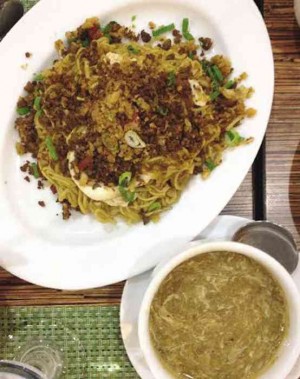
Tuguegarao fed me and my friends well. Among our guilty pleasures were a whole organic lechon with skin so crisp we snacked on it like chips, and the Imelda fish (bighead carp), which we found at the Don Domingo Wet Market and had our hotel chef cook it as sinigang and grilled steaks.
But even if we had the privilege to eat such indulgences, it was the province’s humble pancit batil patong that definitely left the biggest impression during our three-day trip.
The city teems with panciteria. At night, vendors convert side streets into busy eateries where locals get a quick fix of the popular noodle dish cooked à la minute. Practically each restaurant has its version of the batil patong as well.
But the original, according to Gloria Caronan who hosts culinary tours in Tuguegarao, is quite different from what many serve these days. It is simply composed of sautéed minced carabao meat and poached egg on top of miki noodles.
It comes with egg soup, which you can either pour and mix with the noodles or consume separately. A condiment of soy sauce, chopped red onions, chili and calamansi typically accompanies the dish.
First taste
Our food-savvy group had our first taste of batil patong at Hotel Roma on Bonifacio Street, where we had a welcome lunch hosted by Lucrecio Alviar, Region 2 Director of the Department of Agriculture.
It looked appetizing, stayed true to the original but had Chinese sausage and a generous serving of crushed chicharon.
The noodles had clumped up and turned cold as it had been sitting on the table, waiting for our party. Still, it lent an appealing mouthfeel, something restaurateur Margarita Fores enjoyed. The flavors were spot-on and the chicharon gave an otherwise mushy dish a most welcome texture.
It was so good that it could have done without the soup.
The whole ginger chicken, kaldereta and crispy pata which we were also served had gone almost unnoticed, while our batil patong got wiped clean in mere minutes.
Dinnertime, we dropped by Ryan’s Special Pancit Cabagan at Bulanao in Tabuk, Kalinga, after visiting a coffee farm. The menu had reasonably priced dishes, but as expected, our group zeroed in on the batil patong.
This version had comparatively flat noodles topped with chopped cabbage, a mound of ground beef and chunks of lechon kawali. The egg soup had a darker hue and was more potent than the hotel’s.
While every forkful didn’t guarantee a crunchy fried pork belly, it still had a delectable combination of meaty flavors.
We were tied down to the itinerary but that didn’t stop us from trying what many locals claim to be the most popular place for batil patong, Eva’s Panciteria.
It was the closest to the original, with softer than al dente noodles crowned simply with a hefty serving of ground cara-beef and poached egg.
No other garnish came with it, except for an oily broth that could have used a little seasoning. It felt like eating burger with noodles; nonetheless, its simplicity made the flavors of the few ingredients stand out.
Countless versions
There simply are countless versions of batil patong. Some have bean sprouts, which add body and hint of fresh produce to the dish. Apart from cabbage and carrots, veggies like snow peas also are added.
Shrimp and hot dog sometimes replace ground beef, boiled quail eggs take the place of the sunny side-up or lightly poached eggs. The pancit Tuguegarao or batil patong has as many varieties as pancit itself—proof of the diversity of Filipino cuisine.
Inspired by the trip, I share my own recipe using ingredients I brought home from Tuguegarao—longganisa and salted pork belly. Enjoy!
Pancit Batil Patong
70 g salted pork belly (ordinary pork belly can be used), sliced to small cubes

6 pc longganisa, taken out of its casing
2 cloves garlic, minced
half a small onion, minced
100 g carrot, peeled and cut to strips
100 g cabbage, cut to strips
Salt and pepper, to season
3 c chicken stock
1-2 tbsp soy sauce
150 g miki noodles
4 eggs
Fried miki noodles, for garnish (optional)
In a pan with oil over medium heat, fry the pork belly until crispy. Set aside.
In the same pan, cook longganisa. Set aside.
Still using the same pan, sauté garlic and onion until soft. Add carrot and cabbage. Season. Saute until carrot is tender. Set aside.
In a pot, pour chicken stock and soy sauce. Mix. When boiling, add noodles. Cook until tender, about 4 minutes. Transfer noodles to plate. Add two beaten eggs to the pot with stock to the stock and heat for a minute. Season to taste. Set aside.
Poach remaining two eggs.
Place cooked longganisa on noodles, followed by sautéed vegetables and pork belly. Top with poached eggs and fried miki noodles. Serve with soup and a condiment of soy sauce, chopped red bird’s eye chili, calamansi juice and minced red onion.
Serves 2-4.













































